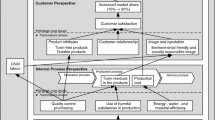Abstract
The option of weighting impact categories according to ISO 14042 on Life Cycle Impact Assessment (LCIA) is particularly difficult for global organizations, as they have to consider a wide range of values. The motivation for employing weighting is usually based on the desire to simplify LCIA output, especially in circumstances where product system tradeoffs occur. Looking globally at regional variations in legislation, consumer values, monetary valuation, existing weighting sets and expert opinions, no globally agreed upon weighting set is likely to be derived. This is due to both the inherent subjectivity of weighting and local variations in environmental imperatives. Hence, the authors recommend that LCIA quantitative weighting, especially those provided in pre-packaged software instruments, should not be employed. Admittedly, to use a spectrum of LCIA results for internal design decisions, some kind of tradeoff analysis has to be performed, especially if comparing competing design alternatives. However, this trade-off analysis should be done separately from the technical LCA study and should reflect values and visions of the global organization, as well as the circumstances of the targeted market, in a qualitative way. For any external communication, none of the quantitative weighting sets can be used.
Similar content being viewed by others
References
Babu PR, Sangle S, Khanna P (1999): Evaluation of Life Cycle Impacts: Identification of Societal Weights of Environmental Issues. Int J LCA 4 (3) 221–228
Barnthouse L, Fava J, Humphreys K, Hunt R, Laibson L, Noesen S, Norris G, Owens J, Todd J, Vigon B, Weitz K, Young S (1997): Life Cycle Impact Assessment-The State-of-the-Art.SETAC 1997,1998
BDI — Association of German Industry (Bundesverband der Deutschen Industrie) (1999): Implementation of Life Cycle Assessments (LCAs) to Inform the Public and Politicians, Cologne, Germany
Bengtsson M (2000): Environmental Valuation and Life Cycle Assessment. CPM Report 2000:1. Chalmers, University of Technology, Göteborg, Sweden
Bond M, Akhtar H, Ball P, Bhanthumanavin D, Boski P et al. (1987): Chinese Values and the Search for Culture-Free Dimensions of Culture. J Cross-Cultural Psychology18 (2) 143–164
Buwal/Bfs (1998): Bundesamt für Umwelt, Wald und Landschaft / Bundesamt für Statistik: Umweltbewußtsein—Umwelt in der Schweiz. Bern, Switzerland (http://www.admin.ch/buwal/d/themen/koord/ bewusst and http://www.admin.ch/ buwal/d/themen/grundl/ beobacht/index.htm)
Cairncross F (1992): Costing the Earth. Harvard Business School Press, Boston, Massachusetts, USA
Dietz et al. (1998, quoted in Hohmann C 1999): Consumers’ Environmental Attitudes and Behaviour Towards the Automotive Industry —A Pilot Study. London School of Economics and Ford Motor Company, September 1999, UK
Erin (1999): Techniques to Value Environmental Resources — An Introductory Handbook (http://www.erin.gov.au/epcg/esd/hand-book/valuatn.html)
Ernst & Young (1998): Integrated Product Policy. Study for European Commission DGXI
Finnveden G (2000): On the Limitations of Life Cycle Assessment and Environmental System Analysis Tools in General. Int J LCA 5 (4) 229–238
GaBi 3.0 (1998): Softwaretool Ganzheitliche Bilanzierung 3.0; Dokumentation, Gewichtung. PE Product Engineering GmbH, Kirchheim/Teck, Germany
Goedkoop M (1995): The Eco-Indicator 95. RIVM Report 9523, Bilthoven, The Netherlands
Governments (1998): Willingness to Pay for Electricity from Renewable Energy Sources. (http//www.erin.gov.au/epcg/esd/handbook/ valuatn.html: http://www.eren.doe.gov/greenpower/willing.htmll
Graedel TE, Allenby BR (1995): Industrial Ecology. Prentice-Hall, UK Hofstetter P (1999): Top-Down Arguments for a Goal-Oriented Assessment Structure. In: Global LCA Village (http://www. scientificiournals.com/lca/village/WIA2 99/TopDown.htm)
Hohmann C (1999): Consumers’ Environmental Attitudes and Behavior Towards the Automotive Industry — A Pilot Study. London, School of Economics and Ford Motor Company, September 1999, UK
Hunkeler D, Yasui I, Yamamoto R (1998): LCA in Japan: Policy and Progress. In: Ökobilanzen VI; UTECH ’98, 19.-20.2.1998
Hunt R, Franklin W (1974): Resource and Environmental Profile Analysis of Nine Beverage Container Alternatives. EPA Report 530/SW-91c, NTIS # PB 253486/5wp
IPOS (1997, quoted in Hohmann C,1999): Consumers’ Environmental Attitudes and Behaviour Towards the Automotive Industry—A Pilot Study. London, School of Economics and Ford Motor Company, September 1999, UK
Itsubo N, Inaba A, Matsuno Y, Yasui I, Yamamoto R (2000): Current Status of Weighting Methodologies in Japan. Int J LCA 5(1) 5–11
Lee KM (1999): A Weighting Method for the Korean Eco-Indicator. Int J LCA 4 (3) 161–165
Ri*Questa GmbH, Unternehmensberatung, Bürstadt, Germany (1999): Umfrageergebnisse der internationalen Umfrage ‘International Environmental Monitoring’, published 1st October 1999, VDI Nachrichten No 39, p 36
Seppälä J (1998): Decision Analysis as a Tool for Life Cycle Impact Assessment. LCA Documents, Vol 4, Ecoinforma Press and ecomed publishers, Landsberg, Germany
Sweden (1998): http://www.environ.se/www-eng/ethreath.htm
Udo de Haes HA, Jolliet O, Finnveden G, Hauschild M, Krewitt W, MuellerWenk R (1999a): Best Available Practice Regarding Impact Categories and Category Indicators in LCIA. Int J LCA 4 (2) 66–74
Udo de Haes HA, Jolliet O, Finnveden G, Hauschild M, Krewitt W, Mueller-Wenk R (1999b): Best Available Practice Regarding Impact Categories and Category Indicators in Life Cycle Impact Assessment. Int J LCA 4 (3) 167–174
Wagner R (1998): Konsistenzprüfung von Kosten-Nutzen-Analysen mit der Kontingenten Evaluierungsmethode, Brandenburgisch Technische Universitat Cottbus, Fakultät Umweltwissenschaften und Verfahrenstechnik (June 1998)
Author information
Authors and Affiliations
Corresponding authors
Rights and permissions
About this article
Cite this article
Schmidt, W.P., Sullivan, J. Weighting in Life Cycle assessments in a global context. Int J LCA 7, 5–10 (2002). https://doi.org/10.1007/BF02978904
Received:
Accepted:
Issue Date:
DOI: https://doi.org/10.1007/BF02978904




